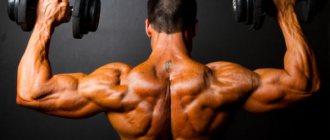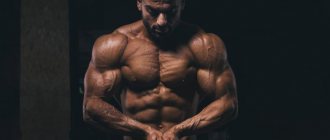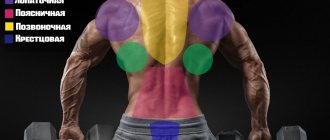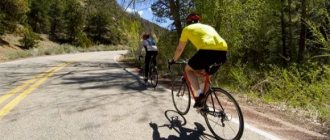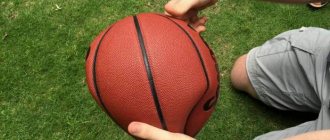Ball-shaped, unfolded shoulders in men are a sign of a competent approach to training the shoulders and good separation of the deltas. The large muscle includes 3 bundles: clavicular (frontal), acromial (middle) and spinous (dorsal). There is no universal exercise in bodybuilding that can be used to pump up all 3 zones at once. For each of them there is a series of compounding and isolating practices. The first ones are responsible for the mass, the second ones draw and polish the contours. Start by working on the front deltas. They work with pressing movements, front lifts, and deadlifts.
Structure and functions
To understand how to pump up the deltoid muscles, you need to know how they work. Anatomically, the deltoid muscle is similar to a thick braid, woven from three main bundles of muscle fibers. Tensing as a whole, it moves the shoulder forward and backward, to the side, down or up, but each bundle, depending on its location, also performs special tasks:
- the anterior bundle, or clavicular part of the deltoid muscle, ensures the lifting of the limbs in front of you and the abduction of the elbows towards the body. It starts from the anterior edge of the clavicle and the upper surface of its lateral (lateral) third;
- middle (lateral) fascicle, or spinous part of the deltoid muscle; raises his arms to the sides. It is attached to the acromial (apical) part of the scapula;
- the posterior bundle, the acromial part of the muscle, is responsible for abducting the arm back. It runs from the lower part of the posterior edge of the spine of the scapula along its entire length to the medial (middle) edge.
Working in various combinations, intertwined fiber bundles provide a full range of movement of the upper limb. The clavicular part, together with the lateral part, bends the arm and moves it to the side; when the anterior and acromial muscles work alternately, the arm bends and extends; if the lateral, together with the posterior, extends and simultaneously abducts the arm.
Why do you need to develop the deltoid muscle?
To answer this question, let's consider its main functions. These include:
- Participation in extension and flexion of arms;
- The muscle, when fully tense, promotes abduction of the shoulder;
- Performs lateral abduction of the arm while rotating the shoulder outward.
In addition, a well-developed deltoid muscle makes a person’s figure more athletic, with broad and well-developed shoulders.
Shoulder width is a hereditary factor, but you can develop the deltoid muscle, which makes the shoulder more prominent and voluminous, by regularly performing certain exercises.
Basic principles of training
Since the deltoid muscle fiber bundles have a special specialization, they can be worked in isolation, effectively influencing the “lagging ones” and reducing the load on those that respond better to the load. If we describe their purpose in terms of the physiology of movements, then we can say that the anterior fascicle and the anterior part of the lateral one perform pressing functions, and the back part of the middle and rear deltas perform traction functions. This means that a comprehensive program for the musculus deltoideus should involve different parts of the muscle and work them from different angles. The complexes consist of basic and isolated exercises:
- basic ones are designed for other muscle groups (for example, chest or back), they simultaneously, and do not specifically load the deltoids;
- isolated ones are designed for fine work, selectively loading certain muscles or areas thereof.
For the front delts, pressing exercises are considered basic. The rear ones are developed with the help of traction; for medium ones, both are used in various combinations. Usually the complex includes 1 or 2 basic and 1-2 isolated exercises; it is recommended to perform each complex for one and a half months, and after that replace it with another.
Before training, do a ten-minute warm-up: warm up your muscles, stretch your joints. Remember that it is impossible to become an athlete neither in a week nor in a month! Learn to dose the load so as not to injure the muscles and damage the shoulder joint. For beginners, it is better to start training with a trainer, and if this is not possible, learn the correct technique from photos and videos on the Internet. Over time, you will learn to feel your body's signals and will independently regulate the weight of the weights and diversify the loads. But don’t forget that at least two days should pass between workouts for the same muscle groups!
Training for women is generally planned in the same way as for men, but has its own characteristics related to the anatomy of the female body and the fact that many women and girls are afraid of turning into warriors with pumped-up shoulders. At home they can use light dumbbells, and in the gym they can use a block crossover machine. Injuries occur less frequently with it, and besides, training on a crossover does not build up large muscle mass, but gives the shoulders relief and elasticity.
Delta and man
Huge accumulations of silt, which have been deposited in deltas for centuries, make these lands extremely fertile. The largest cities and entire civilizations arose in the deltas of large rivers - for example, Ancient Egypt in the Nile Delta. The world's largest delta of the Ganges is now home to over 145 million people!
True, enormous floods also occur in these deltas. Firstly, due to the fact that the channels can no longer break through the thickness of sediments and are forced to look for new channels. And, secondly, because at the mouths of the river, having collected the water of all tributaries, they are the most abundant.
Deltas are convenient for the construction of ports. At this “crossroads”, goods delivered by river can be reloaded for transport by sea. Sea cargo is heading up the river to meet them. The world's largest ports are located in the river deltas - Rotterdam, Hamburg, Vancouver, St. Petersburg, Alexandria, Osaka.
In deltas, a lace of small reservoirs and dense thickets (floodlands) often forms - a real paradise for fish, birds and other animals. Here people hunt, fish, and relax. The Danube Delta, home to dozens of rare and endangered species, has been declared a UNESCO World Natural Heritage Site, and the Danube Delta International Biosphere Reserve has been organized here.
Ancient deltas are places where currents once sorted and deposited vast reserves of sand and gravel. Here they set up quarries and extract these materials.
Unsustainable human activities - the construction of hydroelectric power stations and irrigation systems, the creation of reservoirs, the plowing of riverbed lands, the discharge of wastewater - are destroying delta ecosystems. For thousands of years now, man has been using what they give him. The time has come to realize that these resources are not endless.
(4 ratings, average 5 out of 5)
Anterior Head
The clavicular part of the muscle is used in bending, lifting, holding the arms in front of the body and above the head; movements with abduction of limbs. Accordingly, to pump it up, they work with weights, lifting them above their heads and in front of them. The Anterior Head lends itself well to development, as it receives the load in most pressing exercises for other muscles.
The basic presses for these beams are: military, Arnold, barbell and dumbbell presses while standing or sitting, and barbell snatches. As isolated exercises, lifts of dumbbells, a barbell (or its plate) in front of you, push-ups in a crossover, push-ups on parallel bars, from the floor, and benches are used. For beginners, we can recommend the following exercises:
| Approaches | Number of repetitions | Pause between sets (min.) | |
| Military press (basic) | 3 | 6 | 3 |
| Arnold Press (basic) | 3 | 8 | 2,5 |
| Alternating lifting of dumbbells in front of you (isolated) | 3 | 12 | 2 |
| Delta stretch | 3-4 min |
Basic exercises are done with the maximum (according to the athlete’s physical fitness) working weight, paying attention to lowering the weight after lifting: lower it as slowly as possible. Stretching on a crossover at the end of a workout causes micro-tears in muscle fibers, and this stimulates muscle recovery and strengthening. This training complex is done on separate days or combined with back muscle training.
Bodymaster.ru recommends Training Plans:
Often the deltoids are trained after larger muscles such as the back or chest. This means that all the energy will be directed to the first group, and nothing will be left on the shoulders. To stimulate growth, a high level of intensity and concentration is required.
The ideal option is to pump up the deltoid muscles on a separate day. This way the intensity will remain high and you will be able to lift more weight. The muscles will be fresh and easily respond to the impact.
Training the deltas in this program allows you to work on the trapezius. They don't require a lot of work, and the various variations of shrug exercises won't tire out your muscles. It is better to work on trapezius after deltoids.
Alternatively, the deltoids can be trained together with the quads and calves. This is a good option - the shoulder muscles will not get tired from working on the legs.
Middle Head
The middle deltoids are the part of the muscle that increases the width of the shoulders. Since the Middle Head's task is to raise the arms to the sides, it is pumped up with presses with the elbows raised upward. Unlike the anterior fasciculus, the lateral fascicle is more sensitive to isolated exercises that provide targeted load.
The most popular basic exercises for middle deltas are seated dumbbell presses, overhead barbells, military and Arnold presses, and barbell rows to the chin. Among the isolated ones there are: one-arm pull to the side on the lower block; standing dumbbell flyouts and others. For example, you can use the following complex:
| Approaches | Number of repetitions | Pause (min.) | |
| Military press (basic) | 3 | 6 | 3 |
| Seated dumbbell press (basic) | 3 | 8 | 2,52 |
| Standing Dumbbell Lateral Raise (Isolated) | 3 | 12-15 |
Do basic exercises with the maximum working weight for you; isolated, repeat as many times as you can, strictly adhering to the technique. Lower the weight slowly to engage more pure muscle fibers and reduce the risk of injury. Like exercises for the anterior bundle, this complex is performed separately or simultaneously with back training.
Delta exercises
Exercises for pumping deltas are divided into basic, which involve several joints at once, and isolating, which put stress on individual areas and one joint. Even at the very start, you should not give up isolation - such movements will have a positive effect on the overall result and will allow this muscle group to develop evenly.
Front beam exercises
All pressing movements on the shoulders should be classified as basic movements on the front beam. In many of them, the middle one works, but the emphasis is still on the front part.
Bench press standing and sitting from the chest
A basic movement that should be performed by both beginners and experienced athletes.
Technique for performing the exercise while standing:
- Place the barbell on the racks at shoulder level.
- Approach the bar and remove it from the racks by using an overhand grip slightly wider than shoulder-width apart (so that your forearms are strictly perpendicular to the floor) and placing the barbell on your upper chest.
- Take a step back, stand straight, feet slightly wider than shoulders and slightly bent at the knees - this is the starting position (IP). You must not bend your back during the entire approach! If you arch your back, reduce the weight.
- Smoothly, without jerking or using your legs, press the barbell up. At the same time, the elbows are slightly bent at the top point - this will help to avoid injuries to the elbow joint.
- Smoothly return the exercise to the IP, you don’t have to touch the barbell to your chest, but immediately begin the next repetition.
- Return the bar to the racks.
This is the most common option. But some athletes lift the barbell onto their chest not from the racks, but from the floor - with a jerk. To do this you need to have experience and appropriate technology. In addition, most in this version lose a certain percentage of the weight of the projectile.
The exercise can be performed while sitting, the technique will be similar, but in this case the load on the spine increases, but the deltoids work worse, as the pectoral muscles begin to engage.
© Makatserchyk — stock.adobe.com
A variation of the latter option is the Smith seated press. In this case, the trajectory of movement is set by the simulator, which reduces the number of stabilizer muscles activated. However, this variation can help you focus specifically on pumping the deltoids, excluding the pectoral muscles and triceps, since there is no need to pay much attention to balance and stabilization of the projectile. Try all the options and choose the one in which you better feel the load on your shoulders.
© Makatserchyk — stock.adobe.com
Bench press
This exercise can also be performed standing, sitting and in Smith. The movement is traumatic, and therefore requires certain preparation - both fundamental (good stretching, strong ligaments) and local (thorough warm-up).
© Makatserchyk — stock.adobe.com
Not recommended for beginners and amateurs in general - it is better to leave this option to professionals.
The technique of execution is also similar to the chest press, only the apparatus is located behind the head; accordingly, we take the barbell to the starting position as with classic squats. The weight here will be slightly less, since it is more difficult to control the projectile, and the movement is unphysiological for the shoulder joints. Be careful when lowering to avoid hitting your head. Also, do not lower the bar too low - it is enough to reach the bottom edge of the ears.
Dumbbell press standing and sitting
One of the best shoulder exercises. Most often, the movement is performed while sitting; in the case of dumbbells, this is the best option:
- IP - sitting on a bench with a vertical back (or located at an angle close to 90 degrees), arms with dumbbells are spread to the sides and bent at the elbows, the projectiles touch the deltas, palms “look” outward.
- As you exhale, press the dumbbells upward in a wide arc. There is no need to touch them at the top point. The elbows should be located under the hands, not moving forward. Do not arch your back to avoid increased stress on the intervertebral discs. At the top point, your elbows should remain slightly bent. Also try to hold the dumbbells so that your little fingers are higher than your other fingers.
- As you inhale, slowly return your hands to the IP position.
© Makatserchyk — stock.adobe.com
When doing a standing press, the technique is similar, but this option is rarely found in gyms.
© Fxquadro — stock.adobe.com
Another variation of this movement is the dumbbell (or kettlebell) press with one hand. When you have already reached serious weights, when pressing two heavy dumbbells, your back may somehow bend. To avoid this, you can reduce the load by performing alternate presses with one arm. This can be done both sitting and standing. Also, with this embodiment, the trapezius muscles are less involved in the work.
© blackday — stock.adobe.com
Arnold press
A variation of the dumbbell press, in which the position of the hands changes throughout the movement. In the starting position, the palms are facing the face, and in the final position, outward. The elbows are directed forward at the start. Otherwise, the Arnold press technique is similar to the previous exercise.
The main difference is that the Arnold press involves the middle bundles more than in the standard case.
Seated bench press
This movement is most similar to a dumbbell press, but here the trajectory is strictly limited by the design of the machine. The exercise is basic, but it should be performed after bench presses with barbells or dumbbells. Another option is to perform it as a warm-up with light weights before doing a heavy bench press.
© Makatserchyk — stock.adobe.com
Raises (swings) in front of you
This is the first isolated delt exercise in this review. It is done standing, with light weights. Can be performed with dumbbells (alternately and with two at once), a barbell, in a lower block or crossover (similarly, with two hands at once and one at a time).
Technique for performing with two dumbbells at the same time:
- IP - standing, feet shoulder-width apart, hands with dumbbells lowered down and located in front of the hips, straight grip.
- Without jerking or inertia, raise your arms in front of you, fixing them for a moment at shoulder level. There is no need to lift it higher - the load from the deltas goes to the trapezius.
- Slowly return your hands to the IP position.
© ruigsantos — stock.adobe.com
If performed with a barbell, one dumbbell or on a block, the technique is absolutely the same.
© Makatserchyk — stock.adobe.com
© Makatserchyk — stock.adobe.com
© Makatserchyk — stock.adobe.com
Alternating swings are also popular. In this case, it is easier to focus on one side. In addition, asynchronous lifts allow you to work with more serious weights. However, do not forget that you do not need to swing your body and throw dumbbells using inertia .
© Mihai Blanaru — stock.adobe.com
Alternating swings can also be performed in a crossover:
© Makatserchyk — stock.adobe.com
Exercises for middle beams
Here the emphasis is on the medial area.
Pull to the chin (broach)
Basic exercise, performed standing. The barbell is most often used, but options with dumbbells, as well as on the lower block/crossover and even in Smith, are acceptable.
© ruigsantos — stock.adobe.com
© Makatserchyk — stock.adobe.com
The traditional version involves a vertical stand and an emphasis on medium buns. To do this, the grip should be wide - wider than the shoulders. Narrow placement of the arms leads to greater load on the trapezius and anterior deltoids.
Technique:
- IP - standing, hands down, straight wide grip holding the bar in front of the hips.
- Using the efforts of the middle fascicles of the deltas, raise the bar to the level of the collarbones or lower, the level depends on the grip - the wider it is, the lower the bar will be. The elbows at the top point are slightly higher than the shoulders.
- Return your hands to the IP under control.
Like the overhead press, this exercise is dangerous . Therefore, the movements are smooth, and the weight of the projectile is relatively small. It is much more useful in this case to give preference to a multi-repetition style - 12-15 repetitions.
Lateral flyes (swings)
Isolated movement. The best way to do it is slowly and technically. Although more often in the gyms you can see it performed in a strength format - with cheating and throwing dumbbells upward with the help of swinging the body. Leave the last option to the professionals; to pump up your shoulders more effectively, this exercise should be done with light weight, without cheating, and in 12-15 repetitions.
Technique for performing swings while standing:
- IP – standing straight, no need to lean forward. Hands with dumbbells are lowered down and located at the sides, and not in front of the hips, with a neutral grip. You can bend them slightly at the elbows.
- Slowly spread your arms out to the sides. At the top point, at which the hands are at shoulder level, the palms are turned so that the little finger is on top - this maximizes the load on the middle bundles.
- Return your hands to the IP. There is no need to rest at the bottom and touch the thighs with the apparatus - immediately start a new repetition.
© Makatserchyk — stock.adobe.com
This exercise can be performed while sitting in a similar way. In this version, it is more difficult to cheat, which in this case is a plus.
© xalanx — stock.adobe.com
Swings can also be done in a crossover, using the lower handles (either with one hand alternately or with both at once). When doing this, the amplitude of movement increases (at the bottom point you can move the handle a little further), and the muscles are tense throughout the entire approach.
© Makatserchyk — stock.adobe.com
© Makatserchyk — stock.adobe.com
Also in many gyms you can find special machines for lateral swings. Here the technique is slightly different - as a rule, you need to bend your elbows and rest their outer sides on the pads of the simulator. In the future, the movement is the same - you need to spread your arms to the sides to shoulder level.
© Makatserchyk — stock.adobe.com
The last version of this exercise can be considered one-arm lateral raises while sitting sideways on a bench. You can use either a horizontal or an inclined bench. You need to lie on it sideways (if the bench is horizontal, place your elbow), take the dumbbell in your free hand with a neutral grip and lift it slightly above shoulder level (not to the vertical). There is no need to bend your arm. Try to feel exactly the middle fascicle of the deltoids.
© Makatserchyk — stock.adobe.com
Exercises for the back bundles
Bent-over flyes (swings)
The position of the body in this movement is almost parallel to the floor. Technique:
- IP - standing in a bent position, arms with dumbbells down, neutral or straight grip, knees slightly bent.
- Spread your arms to the sides, fixing them at the top point for a moment and trying to achieve maximum muscle contraction.
- Slowly return your hands to the IP position.
© Makatserchyk — stock.adobe.com
If you are uncomfortable doing the exercise while standing, you can similarly bend over from a sitting position or rest your forehead on the bench for balance.
There is another option for such exercises - lying face down on a bench. In this movement, the rear bundles are even more isolated, since assistance from the legs and body is eliminated. Here it is better to perform the movement with a straight grip and bent elbows so that the load does not go to the middle bun.
© Makatserchyk — stock.adobe.com
The exercise can also be performed in a crossover. Here the amplitude will be even a little greater, since when you take the right handle in your left hand and vice versa, at the lowest point you will move your arms further, and the deltoids will already be tense.
© Makatserchyk — stock.adobe.com
Reverse flyes on the Peck-Deck machine
This exercise builds the posterior deltoids and strengthens the rotator cuff muscles—a good option to prepare your shoulders for bench presses.
Technique:
- Adjust the seat height and handle position. Your arms should be raised to shoulder height and parallel to the floor.
- IP – chest pressed against the back of the machine, hands held in front of you with a neutral grip on the handle. At the start, it is advisable to spread your arms slightly so that the load rises a little.
- Extend your arms all the way (your elbows are behind your back), achieving maximum contraction of the bundles at the end point.
- Take a short pause and return your hands to the IP.
© fizkes — stock.adobe.com
Leads in crossover
This exercise uses the upper handles. There are two main implementation options:
- In the first, you grab the opposite handles with your hands, raise your arms to just above your shoulders and spread them to the sides. Perform the movement slowly and with light weight, trying not to squeeze your shoulder blades.
© Makatserchyk — stock.adobe.com
- The second embodiment involves a rope handle. Take it with both hands, take a couple of steps away from the crossover stand and pull the handle towards you, moving your elbows to the sides. An important point is that in most cases this exercise is performed with the arms located in a plane parallel to the floor. A slightly different technique will help to achieve a better effect, in which the arms in the extreme position are in a position as if you were showing a double biceps from behind. This is discussed in detail in the following video:
Posterior Head
If the middle delts are responsible for the width of the shoulders, then their massiveness depends on the rear ones. The Posteriоr Head takes the arm back, so the maximum tension on this bundle is provided by traction exercises on the back. However, in none of them does it take on a load sufficient for processing, so it is more difficult to work with it than with other beams.
The following are conventionally accepted as basic exercises: bent-over barbell rows to the chest (straight grip), dumbbell rows lying on your stomach, horizontal rows on a machine. Isolated swings of dumbbells through the sides in an incline and reverse flyes in the simulator are used. The Posteriоr Head training complex can be selected as follows:
| Approaches | Number of repetitions | Pause (min.) | |
| Bent-over barbell row (basic) | 3 | 8 | 2,5 |
| Dumbbell row lying on stomach (basic) | 3 | 10 | 2 |
| Reverse dilutions (isolated) | 3 | 12 | 2 |
| Bent over dumbbell swings (isolated) | 3 | 15 | 2 |
The barbell exercise is designed to train the back muscles and does not sufficiently load the rear deltoids. To increase the impact, reduce the weight of the projectile and perform movements by changing the technique. Grasp the bar with a shoulder-width grip and pull the barbell to the level of your lower chest; At the top point, freeze for one or two seconds and slowly lower. Concentrate, feel the tension in your rear deltoids. Perform the program alone or on the day of your chest workout.
Arnold press
Purpose of the exercise: Development of the anterior and middle delta bundles. Also assisting muscles are: trapezius, triceps, upper pectoralis major, coracobrachialis and serratus anterior.
This exercise became popular thanks to Arnold Schwarzenegger and has firmly established itself in the hearts of many fitness and bodybuilding lovers. If performed correctly, the tension in the shoulders will be constant, and the range of motion is very favorable for building muscle mass.
Initial position:
- Sitting on a bench with a strictly vertical back, pressing your back tightly against it.
- Bend your knees at a right angle, spread them wide and place your feet firmly on the floor.
- Raise the dumbbells to neck level. Bend your elbows at a right angle.
- Turn your hands with your palms facing you.
Technique:
- As you exhale, press the dumbbells vertically upward, while turning your hands with your palms facing outward.
- At the top point, your palms should be facing forward. Take a short break.
- As you inhale, smoothly return the dumbbells to their original position, turning your palms in the reverse order.
Recommendations:
- It is recommended to take lighter dumbbells than usual.
- At the top point, the elbows should not be straightened completely: leave them slightly bent.
- The press is performed smoothly, preferably without a pause at the bottom point. Jerks and accelerations will cause the load to be transferred to the spine.
Workouts for busy people
But what if you don't have time to go to the gym, have no idea where your deltoids are, but don't like your reflection in the mirror? Dumbbells will help you “tweak” your shoulders at home! Start with two exercises, doing 8-12 reps of each in four sets.
- For the front beams. Hands with dumbbells at shoulder level, extended in front of you. Raise them, then slowly lower them as low as possible and slowly raise them there.
- For the back beams. Bend forward, bringing your hands with dumbbells over your knees (palms facing inward). Spread your arms to the sides above shoulder level and slowly lower them. At the same time, the wrists “twist” to the sides, but the body does not move.
- An ordinary horizontal bar will also help you quickly get your shoulders in shape. Pull-ups will not replace a full set of exercises for the deltoid muscles, but they are a good way to keep yourself in good shape.
- Partial pull-ups. Grab the bar with a reverse medium grip. Pull yourself “to the middle”, and not to the highest point, bend your forearms, bring your collarbones as close as possible to the bar. Hold for 1-3 seconds, lower.
- Grab the horizontal bar with a shoulder-width grip. Lower your shoulders, take them back. At the top, touch the bar with your lower sternum and lift your chin above the bar.
When you go outside, you shouldn’t immediately rush to the horizontal bar and start doing pull-ups: such haste will do more harm than good, and at best you’ll end up with a few unpleasant sprains. Warm up, perform stretching movements and warm up your muscles. If you are doing exercises, running in the park or working out on the playground, approach the horizontal bar after the main set of exercises. Perhaps over time you will feel that your body does not have enough load and will continue to exercise in the gym.
Treatment and diagnosis
If pain appears in the shoulder, there is a suspicion that it is caused by inflammation or stretching of the deltoid muscle. Treatment should only be prescribed by a medical specialist who can correctly diagnose the problem and find a solution.
For example, if the axillary nerve is damaged, the motor fibers of which are capable of innervating the delta, the skin of the shoulder and the teres minor muscle. With such damage, it is impossible to raise the shoulder, and, in addition, the sensitivity of the skin of the shoulder is impaired. When the deltoid muscle is damaged, the pain is concentrated precisely in the affected part, and does not spread to adjacent areas, as happens with all other muscles.
To avoid injury to the deltoid muscle, you should ensure that the exercises are performed correctly. Before physical activity, you should definitely stretch your tendons. When performing presses, you should not use a wide grip. The best position is shoulder width or slightly wider. In addition, you need to move your arms back correctly. If an injury occurs, you should immediately stop chest loading, as well as all other exercises that cause pain in the deltoid muscle.
Treatment of the deltoid muscle includes the following methods:
- Mobilization by stretching - performed by a doctor.
- Postisometric relaxation – performed under medical supervision.
- Self-administered post-isometric relaxation. To stretch the back of the injured deltoid muscle independently, without the help of a doctor, the patient lowers the hand of the injured arm onto the shoulder of the other arm. Then, grabbing the elbow of the healthy arm, he stretches the back, using traction on the elbow through the chest. The stretching procedure is performed under the supervision of a physician. To prevent displacement of the scapula during the maneuver, the doctor fixes it from behind with his palm.
- Deep massage. Having felt the painful lumps, perform a massage along with ischemic compression. A similar effect is performed with passive shortening of the muscle, which involves a pincer-like grip and kneading, and with light tension of the muscle, which involves acupressure or longitudinal massage.
- Self-mobilization by stretching. It is performed in a standing position. The injured person, standing in the doorway, places the inner surface of his forearms on the side jambs (the door must be open) with his arms down or at an average level. The patient holds his head straight, his neck is not extended, and his lower back is straightened. One leg is in front, its knee is bent. The patient, bending his leg forward, smoothly moves for a couple of seconds into the doorway. Next, the patient relaxes and performs breathing movements, preparing for repeated stretching.
Biomechanics
The front bundle of deltas is included in the work when raising your arms in front of you , as well as in pressing movements . For example, with a classic bench press. It is for this reason that the front head of the deltas is usually well developed in most athletes and, compared to the front and rear, should be given a little less attention.
In accordance with the principle of biomechanics of the work of the shoulder muscles, almost all exercises for the front delts in one way or another include raising the arms or various types of presses.
How to pump up deltoids in a split
In most cases, deltas are not given enough attention. It can be difficult to dedicate a day exclusively to this muscle group. However, like other important muscle groups - legs, back, chest - the deltoids also require separate training.
If you decide to do split training, first familiarize yourself with its concept in order to correctly select exercises and determine the number of days. If you combine deltoids with other muscles, start training with deltoids. If you think that another muscle group is more important, then start with it.
If you combine pumping up the deltoids with your back, then it is advisable to start with the posterior part of the deltoid muscle (variation: you can start with the middle one). This is justified by the fact that if you hit your shoulders first, you won’t be able to fully load your back. Train the big muscles first, then the small ones. Below is a four-day split training program for advanced athletes.
